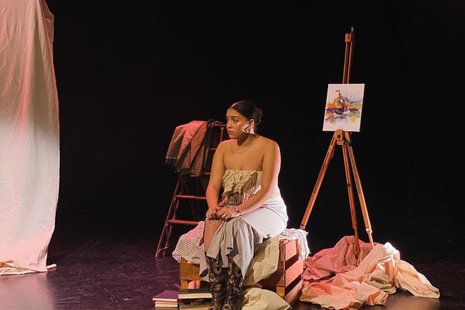Can Camdram and dance make ideal partners?
From a base of personal experience, Gina Stock evaluates the successes and failures of incorporating dance into student theatre

Having danced competitively for many years, Cambridge theatre was a breath of fresh air for me. My first major Camdram experience, Singin’ in the Rain, was a tap musical where nearly half of the cast could not tap to begin with; a major contrast to my theatrical upbringing at the All England Dance Finals. Gone were the days of leotards and pointe shoes, goodbye to the cast understanding the choreographer’s French ballet terms. Cambridge theatre is heavily accessibility-focused (as it should be, considering we are not a drama school) which means that in order to dance, one does not have to have danced.
“A choreographer cannot hold the abilities of the cast responsible, but can work around them to produce something of quality”
But does the accessibility of dance in Cambridge theatre compromise on quality? There is always this risk. Casts are full of ‘non-dancers,’ which is a term that diminishes the effort that an actor is putting into the performance by focusing on the fact that they did not have a prior knowledge of the style. Many cast members are incredibly skilled movers, and often choreographers are working with people who may not know what a ‘pas de bourrée’ is, but can execute it perfectly after careful instruction. Just as a good craftsman never blames his tools; a choreographer cannot hold the abilities of the cast responsible, but can work around them to produce something of quality.
Reflecting on my twelve choreography credits, the skill that I encourage directors and choreographers to perfect is the art of creative choreography that works with, rather than against, the actor’s abilities. This admittedly took time to perfect: I’m sure I sent the cast of Chess nearly insane with my ambitious folk patterns and contemporary ballet that, in hindsight, were too complex and distracted from the vocals and important lyrics. However, by the time I got to The Drowsy Chaperone, using simple but effective movements that allowed actors the headspace to use their faces and focus on their harmonies too meant that the overall picture was much more complete.
Of course, there are moments where Cambridge theatre could afford to give a little more attention to the quality, and accuracy, of the dance being employed. Working on shows where the choreographer’s application pack mentioned ‘folk’ styles fills me with apprehension, as there is a level of base knowledge required to ensure this is executed with cultural accuracy. For example, the work I did for CUADC/Footlights Pantomime 2022: Treasure Island required me to draw on the very finite knowledge I have of Scottish and Irish folk dance for a ‘sea shanty’-style piece.
“If the actors are at nearly-professional quality, why shouldn’t the dance be too?”
Similarly, ETG 2023: The Tempest used a track by Afro Celt Sound System where my Irish folk dance training came in handy. However, it was still a careful task of combining folk, mystical and fantastical elements and colonial themes all into a 5-minute piece for ‘non-dancers.’ Directors should do their own research too, and should know the particular style for which they’re looking. Even European folk has such a diverse range of styles, from Andalusian flamenco to Italian tarantella, English Morris dance to Provence farandole; it is not enough to simply request ‘folk.’
It is also probably time to ditch the interpretive ballet-contemporary fusion that enters musicals and plays as a manifestation of the principal’s feelings; something I am guilty of also with Chess. While movement can be incredibly effective in conveying feeling and blurring the lines between reality and fantasy (Metamorphosis comes to mind) sometimes adding contemporary dance to a piece with ‘non-dancers’ really diminishes the quality of the theatre. Many a piece of theatre has highly skilled actors delivering nearly-professional performances, which will be disrupted by a half-hearted, non-technical attempt at contemporary dance in between scenes. If the actors are at nearly-professional quality, why shouldn’t the dance be too?
All in all, Cambridge theatre was a much more welcoming place than the competitive dance scene which I knew so well, and is still hopefully a welcoming space for those completely new to dance too. Promoting links between Cambridge theatre and the Cambridge dance societies will only increase the quality of choreography and dance within productions. Moreover, there does not have to be a choice between accessibility and quality, as the power lies in the hands of the choreographer. Cambridge theatre should be able to achieve excellence in dance as well as acting, and if it can work with the skills available, it could be on its way.
 Comment / Cambridge students are too opinionated 21 April 2025
Comment / Cambridge students are too opinionated 21 April 2025 Interviews / Meet the Chaplain who’s working to make Cambridge a university of sanctuary for refugees20 April 2025
Interviews / Meet the Chaplain who’s working to make Cambridge a university of sanctuary for refugees20 April 2025 News / News in brief: campaigning and drinking20 April 2025
News / News in brief: campaigning and drinking20 April 2025 Comment / Cambridge’s tourism risks commodifying students18 April 2025
Comment / Cambridge’s tourism risks commodifying students18 April 2025 Comment / Does the AI revolution render coursework obsolete?23 April 2025
Comment / Does the AI revolution render coursework obsolete?23 April 2025





